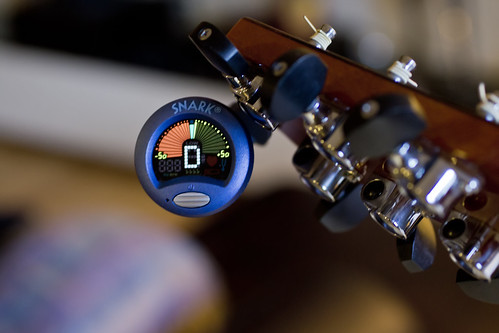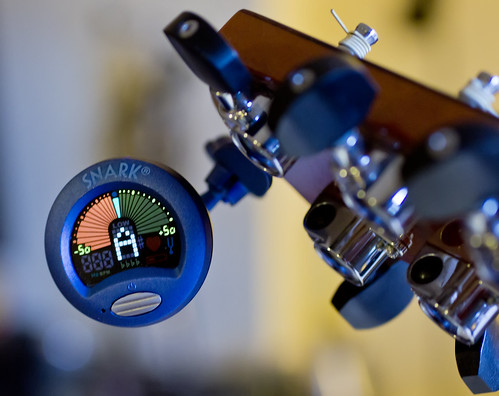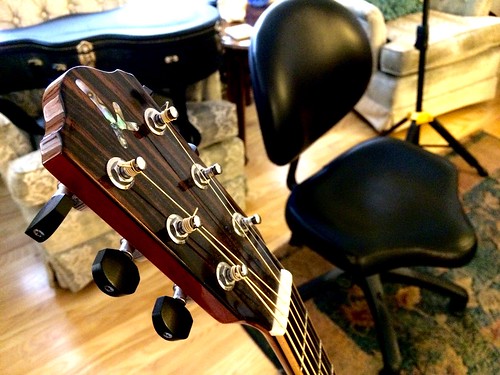
 |
|
#1
|
||||
|
||||
|
I've been enjoying the latest issue of Guitarist magazine that features James Taylor on the cover. The issue not only has an interesting interview but a lot of information and examples of his playing style and technique. If you are a JT fan, it's probably a must read.
In the article, he refers to always doing "tempered tuning" where for standard tuning he tunes 5 of 6 strings some degree flat. He does this because he plays a lot with a capo and the capo tends to pull the guitar slightly sharp. His setup is as follows: 1st string (E): tune to E 2nd string (B): -5 cents 3rd string (G): -4 cents 4th string (D): -8 cents 5th string (A): -10 cents 6th string (E): -12 cents He states other benefits also such as a wider, more forgiving tuning as you play up the neck, not having the 3rd in a chord ring sharp, and a better ring from the bass strings. My Snark and Plant Waves clip on tuners are not the best tools to get the tuning this precise but I tried as best I could with one of my Snarks and think I got it close and I liked what I heard both with and without the capo. Need to get a more sophisticated tuner like a Peterson if I am going to use this technique. Anyone else tried this out?
__________________
Doerr Trinity 12 Fret 00 (Lutz/Maple) Edwinson Zephyr 13 Fret 00 (Adi/Coco) Froggy Bottom H-12 (Adi/EIR) Kostal 12 Fret OMC (German Spruce/Koa) Rainsong APSE 12 Fret (Carbon Fiber) Taylor 812ce-N 12 fret (Sitka/EIR Nylon) |
|
#2
|
|||
|
|||
|
I like the JT tuning also. It is very similar to the Petersen tuner's sweetened tuning from what I understand. I don't have that tuner, but I am able to get to the JT or Petersen settings pretty easily using the Cleartune smartphone app, which has a nice display of the cents markings.
The JT settings I saw originally from a video of his also had the high E string slightly flat, which makes more sense to me. Why wouldn't you want all of the strings to not go sharp when fretted or capoed? Here is what I have for the JT tuning; the Petersen is different by a cent for several strings, but I don't think that makes any discernible difference, and it's not easy to tune exactly within a cent anyway: High E -3 B -6 G -4 D -8 A -10 E -12 Dick
__________________
Collings: D2HT, OM1T, 01MAPLE Kremona: Fandango hybrid nylon string |
|
#3
|
|||
|
|||
|
Even tempered tuning for the guitar is one of the first things you learn if you've ever taken lessons from somebody who went to Berklee School of Music. You don't need a mechanical or electric tuner to do it. Just do it this way:
1. Tune your A string to an A440 tuning fork.It makes your guitar "in tune with itself" all the way up the neck (provided your intonation is correct) and has the added benefit of helping develop your ear. 
|
|
#4
|
|||
|
|||
|
I've been using Peterson's Stroboclip "sweetened" tunings for years, as does my playing gang, and I LOVE them. It really is sweeter up and down the neck.
Also the sweetened tunings do not throw off my VoicwLive3 harmonies, which are triggered off the guitar, so these +/- tunings are very subtle. I tune all my guitars down 1/2 step and use Peterson's sweetened tuning, to my ears it's a better way to tune.... 
__________________
Rich - rmyAddison Rich Macklin Soundclick Website http://www.youtube.com/rmyaddison Martin OM-18 Authentic '33 Adirondack/Mahogany Martin CS OM-28 Alpine/Madagascar Martin CS 00-42 Adirondack/Madagascar Martin OM-45TB (2005) Engelmann/Tasmanian Blackwood (#23 of 29) Last edited by rmyAddison; 08-04-2015 at 09:17 AM. |
|
#5
|
||||
|
||||
|
Quote:
James Taylor's tempered tuning works for him, on his guitar, and may or may not apply to (or sound good) with you on your guitars. Several of the Peterson tuners have built in tempered tunings, and yes, I tried them, but went back to my own tempering. I know on my guitars which strings I tweak a slight bit flat or spot on… And you can shade strings very easily with a simple Snark tuner, you don't need a Peterson or other 1/10 cent tuner unless you think James Taylor's tempering is holy grail. If I pluck a string rather gently and watch the screen to see if it initially bumps into the yellow sharp/flat, then settles spot on or still sharp/flat, I can adjust notes nearly as closely as I can with my Peterson. Slightly sharp…  Spot On…  If they flicker slightly flat/sharp once they settle, those are fractions of cents. Each mark on a Snark is a bit over 3 cents. The iOS & Android versions of Petersons iStroboSoft are professional apps and cost (via in-app purchases) more money for specialized features. Unless you are a Steel guitar player, or Keyboard player, orchestral string player, etc. the whole upgrade is likely not necessary. Even the simplest version of the mobile Peterson apps will give you accurate and detailed readings in cents. Hope this adds to the discussion... |
|
#6
|
|||
|
|||
|
"Tempered Tuning" is simply what good guitar players have been doing since the instrument was invented.
The guitar is an imprecise instrument. In the days of the tuning fork, you'd get your primary pitch from the fork and go from there. Once you got it tuned to sound good on both G & D chords, or E & A, you'd be ready to go. However, if you checked it by a modern digital tuner, you'd find that every string was not right on. It was "tempered" or "sweetened". Most of us using a Snark or something along those lines do it now. Tune to the tuner, then "fix". The Peterson allows that to be preset. But bear in mind that what JT says for his guitar as far as exact +/- cents on each string is not necessarily what your guitar will want. |
|
#7
|
|||
|
|||
|
LOL! Looks like Larry & I were thinking of the same caveat at the same time.
 P.S. I had a Peterson for a year, then sold it because I personally found it to be a PITA to use. |
|
#8
|
|||
|
|||
|
Quote:
|
|
#9
|
|||
|
|||
|
Every guitar is different, but none of them ever sound good tuned sharp? Every string needs to be slightly flat with respect to a standard reference tuning, but still be in tune with itself, if that makes any sense.
Have experimented quite a bit with various tuning apps, open tunings, standard pitch and not so standard pitches, switching back and forth with different Capos. For me the Guitar Toolkit by Agile Partners on my iPhone is excellent. For whatever reason on the guitars I have owned the low E and B needs to be noticeably flat in particular and or need attention. The G string likes to catch in the nut and prevent tuning up to pitch. The JT method works well, but I think it's a little too arbitrary maybe. The gist of it is good though. Notice it's not linear, that %#€ing B string needs a little extra. What I have been unable to do effectively is find an acceptable tuning that allows a Capo to be installed or removed and not be off enough to be cringeworthy, at least depending on Capo fret position. Some people aren't picky about being in tune, it's important I think.
__________________
Guild DV4 (Westerly) |
|
#10
|
|||
|
|||
|
I play in a lot of tunings and can use four or five in one set. I use a capo as well. I wouldn't play a big without checking the tuning in between each song. It doesn't take long and I do it while introducing a song.
I am very suspicious of any guitarist who slaps on a capo and doesn't check the tuning! It doesn't matter for rock and roll but for acoustic playing!
__________________
------ AJ Lucas Pavilion Sweep fan fret Santa Cruz OM/E (European Pre War) Martin J40 |
|
#11
|
|||
|
|||
|
Quote:
best rgds |
|
#12
|
|||
|
|||
|
I've been using the Kevin Ryan method and really like it. No tuner necessary other than to find the open D.
1. Tune the D string to a known source 2. Pluck the 12th fret harmonic of the D then tune the G (fretted at the 7th fret) to this harmonic. 3. Pluck the same 12th fret harmonic of the D then tune the B (fretted at the 3rd fret) to this harmonic 4. Pluck the 12th fret harmonic of the G and tune the High E fretted at the 3rd fret to this harmonic 5. Tune the 12th fret harmonic of the A to the G fretted at the 2nd fret (pluck the harmonic first!) 6. Tune the 5th fret harmonic of the Low E to the High E open (pluck the harmonic first!) |
|
#13
|
||||
|
||||
|
Quote:
I don't put it on a bench, but tail on the ground facing me for three strings and flipped back to me for the other three. I'm slow (and older) and take my time to measure the strings for the length I want. I use one wrap above the shaft hole, and the rest below, which pinches the string around the end. I do more wraps for two reasons…
I used to use a standard string peg winder, but these days I use a small Black & Decker lithium powered screwdriver with a string peg winding bit. It doesn't use AA batteries - I just had those and the picks in the picture for scale. It plugs into a charger/wall-wart. With Gotoh 510 tuners, it takes 18 full revolutions of the tuning key to accomplish one wrap. I put 2-3 wraps on the 6th, then it accumulates at the rate of about a wind or tune per wound string. Strings 1-2 I wind about ˝ the way down the shaft normally. Sometimes the 3rd string is a wrap or two short of the bottom of the shaft.    It just takes a little patience, and a bit of time. I know it's the trend to throw one wrap at the top nowadays, but I'm a bit old-school, and where I used to break third strings (with Elixirs) from all my tuning rampages, it has stopped happening since I started wrapping more wraps around the shaft. I NEVER pre-cut strings. Once they are strung, and stretched out come the nippers. |
|
#14
|
|||
|
|||
|
Thanks for taking the time to explain this Larry . I'm probably older & slower ... ( 57 ) ... I may need to read that several times to get a real sense of how you do this from start to finish ... I have for years been following a method I printed out & laminated ( how tragic is that ? ) from Taylor 's on line pages .... I think it was from around 1999 . It works perfectly but doesnt look as neat as your method .
|
|
#15
|
|||
|
|||
|
Quote:
__________________
"Still a man hears what he wants to hear, and disregards the rest." --Paul Simon |